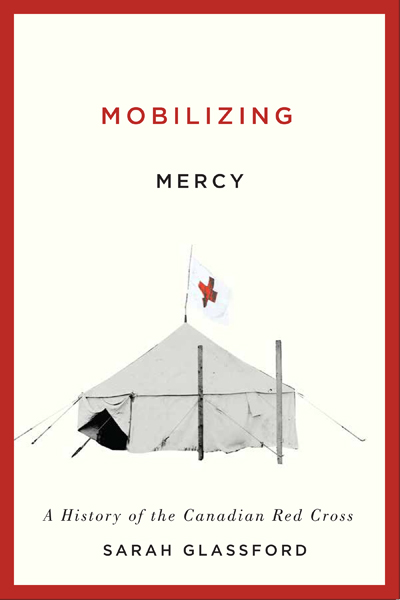by Sandrine Murray
This blog is now cross-posted on the McGill-Queen’s University Press website.
On Friday, April 28, 2017, the Canadian Network on Humanitarian History (CNHH) hosted a book launch for Mobilizing Mercy: A History of the Canadian Red Cross, by social historian -and a founder of the CNHH- Sarah Glassford. Members of the Red Cross were in attendance, including CEO of the Canadian Red Cross, Conrad Sauvé, who opened the evening with a few words of introduction.
The following includes clips of the launch and a Q&A with Glassford about her book, its reception, and humanitarian history.
Is there much written about its history or about humanitarian history in general?
Over the years a number of former volunteers or leaders have written short books about their particular Canadian Red Cross branch or provincial division, often to celebrate some anniversary or major achievement (for instance, the end of the Second World War). And since the 1980s a handful of historians have studied certain CRC programs like outpost nursing, or prisoner-of-war relief, but the only attempt at a history of the organization as a whole was written in the 1960s, and largely relied on the anecdotes supplied to the author at that time. So Mobilizing Mercy draws together what we already knew from these previous works, but also tries to fill in a lot of the gaps while at the same time moving beyond anecdotes or specific branches and programs, to paint a portrait of the national organization over an extended period of time. I hope that both Red Cross supporters and scholars will continue to investigate specific programs or local efforts, because there is a lot more to be explored, but now they will have a clear sense of the larger institutional context in which those things took place. As for humanitarian history in general, it is a small but growing field, and each year there is more excellent scholarship to draw on. It is exciting to be part of a field that is alive with debate and innovation, as scholars and practitioners try to map out what has been taking place over the past century or two and how it relates to today’s explosion of humanitarian aid, so-called “complex emergencies,” humanitarian military interventions, and so on. Groups like the CNHH are a part of that conversation.
from Sandrine Murray on Vimeo.
So far, what has been the response you have received from the book?
It has only been available for about a month, so I have not received much feedback yet. But the peer reviewers were very positive, and both the copyeditor and indexer who worked on it with me said they found it really interesting.
from Sandrine Murray on Vimeo.
Did you expect this response?
I think every author hopes readers will enjoy their work, while most scholars probably think everyone should share their all-consuming fascination with their research topic (although this a bit much to expect). So I definitely hoped for it. I tried to write a book that would make a meaningful contribution to the scholarship of Canadian history, and humanitarian history more broadly, but also one that would be useful and enjoyable for volunteers, donors, and staff of the CRC today. So I think I will be most pleased if, a year or two from now, I hear from some CRC folks that this has been the case.
from Sandrine Murray on Vimeo.
Did you receive any interesting feedback from the launch?
What I found most interesting about the launch was the fact that audience members came from such a variety of backgrounds, including present-day national CRC leaders and long-time volunteers, historians of medicine and nursing, historians of wartime, historians of humanitarianism, social historians, and members of the general public. It made for a lively discussion at the end, and speaks to the fact that the CRC has had an enduring impact on many areas of Canadian — and international — life.




0 Comments
2 Pingbacks